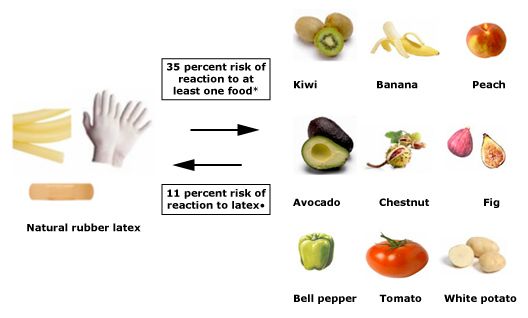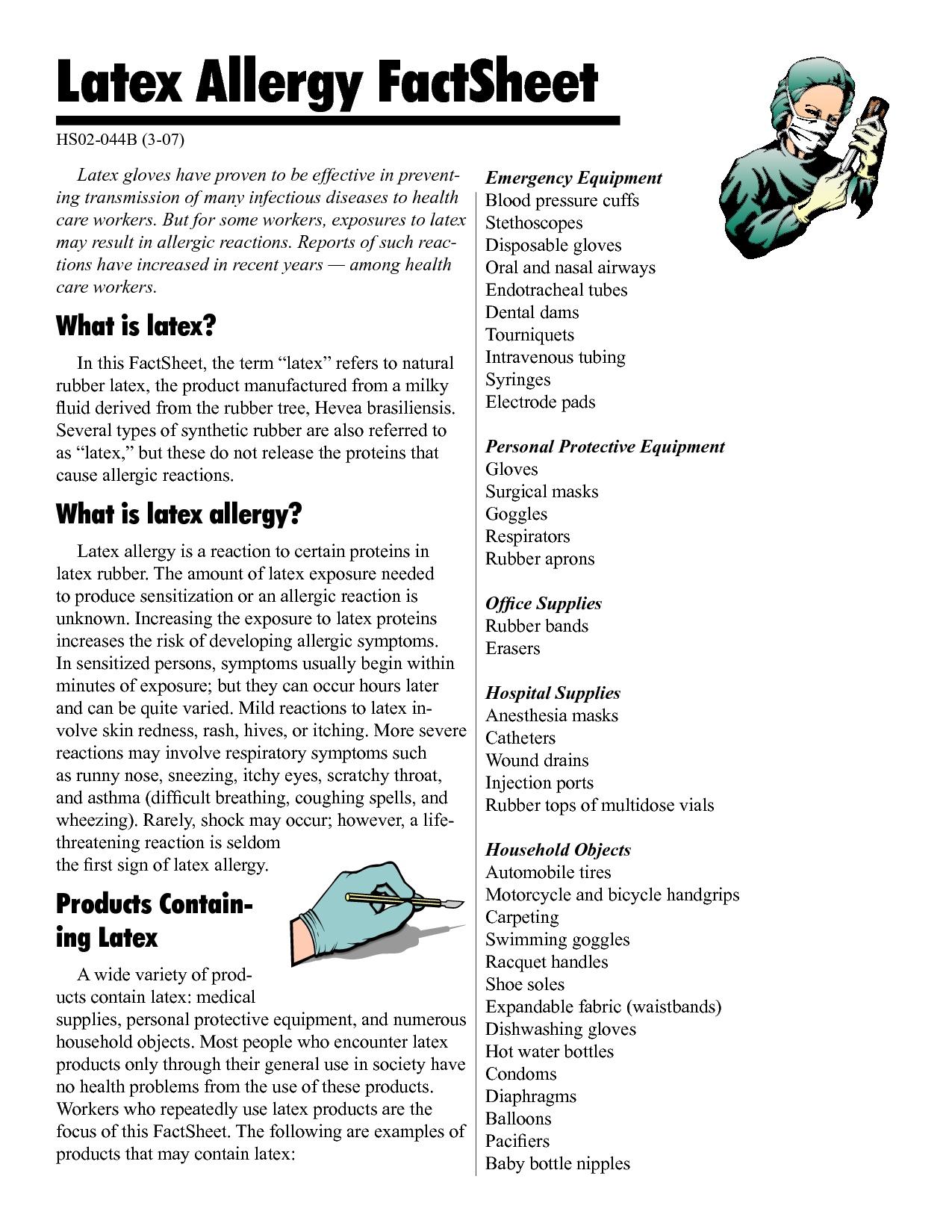Irritant Dermatitis Is The Most Common Adverse Reaction To Latex
Most adverse reactions to latex are irritant dermatitis, which is not an immediate allergic reaction. It results in rough, dry and scaly skin, sometimes with weeping sores. It is made worse by sweating and friction under rubber gloves, but can also occur from frequent hand washing with harsh soaps.
Even though irritant dermatitis is not an allergic reaction, absorption of latex through damaged skin increases the risk of developing latex allergy with ongoing exposure. Recognition and treatment of this condition is therefore recommended to reduce the risk of developing latex allergy.
What Are The Types Of Latex Allergy
There are two types of allergic reactions to natural rubber latex. The types of latex reactions are:
- IgE-mediated latex allergy : A person with type I latex allergy is allergic to a protein from the natural rubber tree. Exposure to latex causes the immune system to make IgE antibodies. These antibodies cause symptoms of an allergic reaction. IgE-mediated latex allergies can be life-threatening.
- Cell-mediated contact dermatitis : This allergy causes skin irritation and inflammation . Blisters may form on the skin, and they may ooze liquid. Cell-mediated contact dermatitis is not life-threatening, but may be very bothersome and in some cases progress to also involve IgE-mediated latex allergy.
Immediate Allergic Reactions To Latex
Immediate allergic reactions , are the most serious adverse reactions to latex. In people who have developed sensitivity to natural latex proteins, contact with latex releases the histamine into the tissues. The result is itching and hives with direct contact, like after wearing rubber gloves, or itchy swollen lips, face or tongue after blowing up balloons. Some people will develop irritation after wearing a condom, inserting a diaphragm for contraceptive purposes, or after visiting the dentist or hairdresser and coming into contact with latex.
Reactions can also occur when latex is inhaled, resulting in allergic rhinitis , or asthma like symptoms. This occurs most commonly in hospitals. The latex proteins can leach out of the gloves with sweaty hands and become attached to the powdered lubricant.
In environments where gloves are being changed frequently, latex on these fine particles can become suspended in the air like pollen.
Anaphylaxis is the most severe allergic reaction to latex and usually occurs in very sensitive patients where latex protein is absorbed rapidly via moist surfaces such as the mouth, nose, throat, vagina, rectum or internally . Symptoms include severe difficulty in breathing and a drop in blood pressure.
How Can You Be Exposed To Latex
You can get exposed to latex:
- Through the , such as when you wear latex gloves
- Through mucous membranes, such as the , mouth, , and rectum
- Through inhalation. Rubber gloves can contain cornstarch powder, which absorbs the latex and can become airborne when the gloves are removed.
- Through the . This can happen when some medical devices containing rubber are used.
Allergic To Latex Foods And Products To Avoid

Recently, I wanted to learn about latex allergy, so I turned to my incredible community of well informed people in my Facebook allergy group. This is what I learned from them, led by Krystal Ahern of the Latex Allergy Awareness Site.
Latex is the milky fluid derived from rubber trees, which is used to make latex products. The same protein is contained in certain foods, which causes cross-reactions in some people who have a latex allergy. Cross-reactive foods are tricky You may be fine with a food one day, but react when you eat it the next time. Waiting days to repeat the same food seems to help reduce reactions, and it allows any symptoms to show themselves clearly. Here is a list of cross-reactive foods for people allergic to latex:
I just found this information explaining the cross-reaction between latex and some foods: Like bananas and chestnuts, avocados contain enzymes called chitinases that are associated with the latex-fruit allergy syndrome. There is strong evidence of the cross-reaction between latex and foods that naturally contain high amounts of chitinase enzymes. If you have a latex allergy, you may very likely be allergic to these foods as well. Processing the fruit with ethylene gas increases these enzymes; organic produce not treated with gas will have fewer allergy-causing compounds.
Awareness And Diagnosis Are Important First Steps
Your doctor will normally ask a series of questions that may help to identify the cause of your problem. This will often be followed by allergy testing to help confirm or exclude the presence of sensitivity to natural latex proteins or chemical preservatives. The types of tests commonly used are skin tests or blood tests for allergen specific IgE, to confirm or exclude immediate sensitivity and patch tests to confirm or exclude contact allergic dermatitis . Information on allergy testing is available on the ASCIA website.
You may be referred to a clinical immunology/allergy specialist for testing.
What Are The Symptoms Of A Latex Allergy
Latex allergy symptoms can range from mild to life-threatening. They can include:
- Rash. Rash is the most common symptom of a latex allergy, Xi explains. A rash can develop within minutes of touching latex, and it usually resolves within hours, she says. You can also develop a delayed rash that occurs days after exposure to latex and lasts days to weeks.People with eczema may also find that latex is a trigger or exacerbating factor for their eczema, Xi adds.
- Respiratory symptoms. Latex can trigger runny nose, sneezing, congestion, cough, wheezing or shortness of breath, according to Xi.
- Anaphylaxis. In severe cases, latex can trigger a systemic reaction called anaphylaxis, which includes symptoms such as difficulty breathing, confusion, dizziness, rapid or weak pulse, nausea, vomiting or loss of consciousness.Anyone with symptoms of anaphylaxis should seek immediate medical attention.
Is Latex Allergy Preventable
Latex allergy is preventable but not curable. Awareness and education are the keys to managing the condition.
The only way for people with latex allergy to prevent symptoms is strict avoidance of latex. Allergy & Asthma Network supports policies where latex gloves are prohibited from use in healthcare and dental facilities, schools, food establishments, and by emergency responders. Many facilities have responded by switching to latex-safe gloves and medical products and supplies.
Who Is At Risk For Developing Latex Allergy
People who have frequent exposure to latex from medical procedures are at greater risk for developing latex allergy. They include:
-
Children with spina bifida
-
Children born with defects of the urinary system
-
Children or adults who have had many surgeries
-
Healthcare providers
People who have allergies to certain foods may also have latex allergies. The foods include: bananas, avocados, chestnuts, kiwi, passion fruit, papaya, figs, peaches, nectarines, plums, tomatoes, and celery.
Causes Of A Latex Allergy
When your body is allergic to latex, your immune system identifies the trigger as a harmful substance and produces antibodies to fight against it. Whenever you are exposed to a product containing latex, these antibodies cause your immunity to release histamine into your blood and trigger symptoms of allergy. The greater your exposure is, the stronger your bodily response will be.
Latex allergy is caused:
- Through direct contact: An allergic reaction to latex is most commonly triggered when you come in direct contact with a product containing latex, such as: latex balloons, condoms or gloves.
- Through inhalation: Certain latex products, such as latex gloves, release particles of latex into the air. If you are allergic to latex, you may inhale these particles and develop an allergic reaction. The amount of latex particles released into the air greatly differs from one product to another.
How To Have Safe Sex If You Have A Latex Allergy
-
People with a latex allergy should use polyurethane, polyisoprene, lambskin, or latex-free female condoms.
-
Some latex-free condoms need certain lube, like polyisoprene condoms need water-based lube.
-
Take care to avoid sex toys with latex and keep medication nearby just in case you have a reaction.
A latex allergy doesn’t have to get in the way of you having a great time in the bedroom. You can still have an amazing sex life with a latex allergy – you just have to be aware of what precautions you need to take and what products you need to use in order to have sex safely.
Do I have a latex allergy? If you experience a rash, redness, swelling, or itching around your genitals shortly after using a standard, latex condom, then you may have a latex allergy. The allergic reaction should subside after several days to weeks.
Here’s what you need to know about latex-free condoms and having safe sex with a latex allergy.
Who Is Likely To Develop A Latex Allergy
About 5% to 10% of health care workers have some form of latex .
Other people who are more likely than most people to get it include those who have:
- A defect in their bone marrow cells
- A deformed or urinary tract
- Had more than one operation
- A urinary catheter, which has a rubber tip
- Food allergies to , bananas, , celery, chestnuts, kiwi, melons, papayas, raw potatoes, avocadoes, , and
Rubber industry workers and people who use s are also more likely than others to get a latex allergy.
What Do You Do If You Have A Latex Allergy

- Wear Medical Identification
- Carry with you at all times:~ Medications, as prescribed by your allergist ~ Non-latex gloves
- ~ Hidden latex on food prepared with latex gloves Lactiferous plants that may have cross-reactive proteins ~ Foods with cross-reactive proteins to natural rubber
- Carry a list of medications prescribed by your allergist
Measures Should Be Taken If Your Job Involves Exposure To Latex
If you are latex allergic and your job involves frequent exposure to latex, you should:
- Use latex free gloves.
- Request that non-powdered latex gloves be supplied to others in your area of work. This reduces airborne latex particle exposure, and has been shown to dramatically reduce the risk of developing latex allergy in occupational settings.
- Look after your hands and have any irritation or rash evaluated by a doctor. An intact skin barrier reduces the risk of developing latex allergy.
- It is important to note that avoiding any contact with latex is also an effective method of preventing latex allergy, particularly for non-medical use such as food handlers and hairdressers.
How Can I Safely Visit A Doctor Or Dentist
Tell them about your latex allergy at least 24 hours before your appointment. The hospital or doctor’s office should have a plan in place so they can use products like nonlatex gloves to treat you.
Ask for the first appointment in the morning. Even if your doctor or dentist uses latex-free gloves for you, there can be latex particles in the air from gloves used with other patients. You’re more likely to avoid these particles by getting there early.
If you have to stay in the hospital, you’ll usually be given your own room, free of products that might give you a reaction.
How Is A Latex Allergy Diagnosed
Your healthcare provider will examine you and ask about your symptoms and exposure to latex. You should share information about other allergies you have, including reactions to foods. If you have a family history of allergies, tell your provider.
Your provider may order a blood test to check if youre allergic to latex. Providers also use a skin prick test to diagnose a latex allergy.
Irritant Dermatitis And Potential Latex Allergy
If you have irritant dermatitis, you can reduce your risk of developing latex allergy in a number of ways including:
- Choose synthetic rubber products if possible.
- If you have to wear latex gloves, ask for the non-powdered variety .
- Request that your co-workers also wear non-powdered gloves.
- Wash hands thoroughly after wearing latex gloves.
- Take care of your hands to ensure an unbroken skin surface.
- Always have skin rashes medically investigated.
- Consider alternative forms of contraception to condoms or diaphragms. Non-latex condoms can be used for barrier protection from sexually transmitted infections.
How Common Are Latex Allergies
Latex allergies are rare. Less than 1% of people in the United States are allergic to latex. Latex allergies have decreased in recent years because more hospitals now use latex-free and powder-free gloves.
Anyone can develop a latex allergy, but some people have a higher risk of developing the condition. Risk factors for latex allergy include:
- Repeated exposure to latex: Frequent contact with latex can cause your body to overreact and develop an allergic reaction. People who regularly wear latex gloves are more likely to develop an allergy to latex. Healthcare providers, dentists and people who work in the beauty industry have a higher risk.
- Frequent surgical procedures: Children and adults who have had several surgeries have an increased risk of developing a latex allergy. Children with are especially likely to have a latex allergy because treatment for the condition includes multiple medical procedures and surgeries at a young age. Medical supplies for these procedures often contain latex.
- History of allergies: Other allergies, including allergic rhinitis , often occur along with a latex allergy. People who are allergic to latex may be allergic to certain foods, including bananas, kiwis, avocados and chestnuts. The connection between latex allergies and food allergies is called latex-food syndrome.
Latex Allergy Guidelines For Health Care Workers
Help prevent latex sensitivity
- Use appropriate work practices to reduce chance of reactions to latex. When wearing latex gloves, use only approved barrier cream. After removing latex gloves, wash hands thoroughly and dry thoroughly.
- Practice good housekeeping: frequently clean areas and equipment contaminated with latex-containing dust.
- Learn to recognize the symptoms of latex allergy: skin rash; hives; flushing; itching; nasal, eye or sinus symptoms; asthma; and shock.
- Care should be exercised when removing latex gloves to reduce the risk of exposure of latex allergens to self and/or colleagues.
Latex allergy in the health care worker
Patients with latex sensitivity
The following guidelines are summarized U.S. Food and Drug Administration advice to health professionals to ensure a patients latex allergy is not overlooked 1):
What Items Contain Latex
There are more than 40,000 products worldwide that contain latex and its often very difficult for people with latex allergy to perform everyday tasks and live a full, active life. Latex allergy generally develops after repeat exposure to medical and consumer products containing natural rubber latex.
The difficulty in managing latex allergy is that latex and latex proteins are found in so many common everyday products. For example, your daily mail may be wrapped in a rubber band; there may be a celebration that includes latex balloons; or the elastic waistband on underwear may cause a sudden and unexpected allergic emergency.
Additional products made with latex include:
- Balloons
- Rubber or latex exam gloves
- Condoms
- Elastic bands, physical therapy bands, rubber bands
- Dental dams
- Stethoscopes and blood pressure cuffs
- Spandex
- Pacifiers and baby bottle nipples
- Mouse pads
We have compiled a list of latex-free sports equipment and latex-free school product List.
If you are unsure whether a product contains natural rubber latex, you can use this sample letterto contact the manufacturer to find out if it contains latex.
Foods To Avoid If You Have Latex Allergies

Ask U.S. doctors your own question and get educational, text answers â it’s anonymous and free!
Ask U.S. doctors your own question and get educational, text answers â it’s anonymous and free!
HealthTap doctors are based in the U.S., board certified, and available by text or video.
How Does A Latex Allergy Develop
-
Latex protein is the allergen that causes a latex allergy. The more exposure that your child has to latex protein, the more likely that an allergy will develop.
-
Foods such as avocados and kiwis and the others listed above have proteins similar to those in natural rubber latex. An allergy to these foods may make a child more likely to develop a latex allergy.
What Causes Latex Allergic Reactions
During an IgE-mediated allergic reaction, your bodys immune system overreacts to a substance that isnt harmful to most people. Your immune system tries to protect you by releasing a chemical called histamine into your bloodstream. Histamine causes symptoms of an allergic reaction. You may experience hives, runny nose and trouble breathing.
An allergic reaction to latex can happen when you touch or come into contact with latex products. Your immune system may also react if you breathe in tiny latex particles in the air. You may not have a reaction the first time youre exposed to latex. With each exposure, your allergic reactions may get worse.
Tips To Avoid Latex Allergy
- While washing dishes, cleaning and doing other household chores at home, wear non-latex gloves only.
- Make sure the clothes you wear do not contain any rubber soles or elastic waistbands. In addition, check that your swimsuits and socks are latex-free.
- Dont wear rubber rain boots and rain coats.
- Keep your bathroom clean from any rubber bath mats, toothbrushes with rubber grips.
- At work or at school, dont use erasers, use paper clips in place of rubber bands.
- Dont use craft items that contain latex, such as rubber cement and paint.
- If you need to wear gloves at work, such as at beauty parlors, restaurants, cleaning companies etc, switch to gloves made from a non-latex material.
- While visiting a hospital, clinic or medical office, call before your appointment and inform them about your latex allergy. Try to get the first appointment in the morning, as there are chances of having minimum latex particles in the air at that time. All the nurses, doctors and attendants should be aware of your allergy, so that they can arrange non-latex: IV tubing, stethoscopes and blood pressure cuffs.
- Check labels of everything without assuming that everything labeled as hypoallergenic is free from latex.
- Use latex-free condoms.
- Some people with latex allergies can develop reactions to certain food products, such as: bananas, apples, avocados, carrots, melons, papayas, tomatoes, celery, raw potatoes, kiwis and . So, beware while consuming these products.
What Are Latex Allergy Symptoms
In most cases, latex allergy develops after many previous exposures to latex. Latex allergy symptoms may include , itching, stuffy or runny nose. It can cause asthma symptoms of wheezing, chest tightness and difficulty breathing. Symptoms begin within minutes after exposure to latex containing products. The most severe latex allergy can result in , a serious allergic reaction involving severe breathing difficulty and/or fall in blood pressure .
Allergic skin problems can occur following direct contact with allergic latex proteins in latex glove products. Symptoms may include immediate itching, redness and swelling of skin that touched the item containing latex. These and other latex allergic reactions are less common now. Many hospitals or doctors offices have switched to non-latex gloves or low protein latex gloves.
A second type of skin allergy called allergic contact dermatitis may be caused by chemicals used to manufacture rubber gloves. This dermatitis is recognized by the and blisters on the back of the hands. It resembles a poison ivy rash, and begins 1 to 3 days after wearing rubber gloves.
Direct physical contact with latex products is not needed to trigger an allergic reaction. Anaphylaxis and severe asthmatic reactions have been caused by inhaling latex proteins in the air resulting from the powder in the latex glove.
Is There A Connection Between Latex Allergy And Foods
Some rubber proteins are similar to food proteins. Therefore, some foods may also cause an allergic reaction in people who are allergic to latex. The most common of these foods are banana, avocado, chestnut, kiwi fruit, and passion fruit. Although many other foods can cause an allergic reaction, avoiding all of them might cause nutrition problems. Therefore, its recommended that you avoid only the foods that have already given you an allergic reaction.
Managing Latex Allergies At Home
If you have a latex allergy, your skin or mucous membranes react when latex touches them. A severe latex allergy can affect breathing and cause other serious problems.
Latex is made from the sap of rubber trees. It is very strong and stretchy. So it is used in a lot of common household items and toys.
What Lube Can I Use With Non
There are three main types of lube: water-based, oil-based, and silicone-based. The best type of lube to use with all condoms is water-based lube, says Rosara Torrisi, PhD, a certified sex therapist based in New York. This is because water-based lube is safe to use across the board, meaning it won’t erode or react with the condom, regardless of what type of condom you are using.
Technically, you can use any type of lube with polyurethane condoms and lambskin condoms. The oil should not break down the material.
However, with polyisoprene condoms, you must use water-based lube. Gersh says oil can cause polyisoprene to deteriorate, so you should definitely avoid it.
|
Water-based Lube |
What Is The Treatment For A Latex Allergy

There is no cure for a latex allergy, but you can take steps to prevent your child from exposure to latex.
-
Alert others to your childs latex allergy. Have your child wear a medical identification bracelet telling others that he or she has a latex allergy. This lets healthcare providers know that they need to avoid using latex when they care for your child. Contact your childs healthcare providers including the dentist and school or daycare nurse. Have them note in your childs file that your child has a latex allergy.
-
Carry an allergy kit. The kit should include:
-
Injectable epinephrine, which can stop an allergic reaction. Your childs healthcare provider will give you a prescription for it.
-
Non-latex surgical gloves, which you can wear or give to others to wear if they must care for your child.
-
A note from your childs healthcare provider stating that your child has a latex allergy.
-
A complete list of medicines your child takes.
Be aware of latex in everyday life. Ask your childs healthcare provider for more information and resources about your childs latex allergy. Check with your childs healthcare provider whether your child needs to avoid foods that have proteins similar to latex. Ask at restaurants and at your childs school whether latex gloves are used to handle or prepare food.
Educate your child, family, and friends. Let them know when and how to use your childs epinephrine. Also, let them know when to call for emergency help.
Can A Latex Allergy Be Treated
There is no cure for latex allergy. If you are allergic to latex, you should:
- Avoid products that contain latex.
- Tell providers, caregivers, teachers and friends that theyre allergic.
- Avoid areas where latex may be in the air, such as a hospital room where providers use latex gloves.
- Talk to your healthcare provider about wearing a medical alert bracelet. In a medical emergency, the bracelet lets others know youre allergic to latex.
- If an IgE-mediated allergic reaction to latex is diagnosed, you should carry with you. Show caregivers, friends and family members how to give you an injection if youre having a reaction and cant inject yourself.
Various Latex Allergy Foods To Avoid
Are you allergic to latex? Do you know you are also allergic to some foods?
People dealing with latex allergy should limit certain foods since they are not good causing cross-reaction.
Here is the list of latex allergy foods to avoid for preventing cross reaction in people who are allergic to latex.

